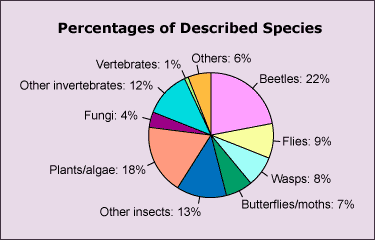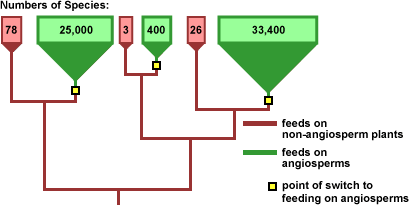Beetles might seem like lowly creatures, but in terms of animal biodiversity, they are tops. Of the 1-2 million eukaryote species that have been described, almost half are insects — and of those insects, more than one third are beetles.

What accounts for all these beetles? Brian Farrell (1998) performed a phylogenetic study that helps to answer that question. He reconstructed the phylogeny of all the major groups of beetles and noted their feeding characteristics. This research allowed him to infer what the ancestral beetles were likely to have been eating and when each lineage switched to a new type of food. His evidence suggests that different beetle lineages switched to feeding on flowering plants (angiosperms) several times during their evolutionary history.
To understand what happened when these switches occurred, Farrell compared sister taxa, clades that are each other’s closest relatives. He saw the same pattern again and again (as shown by the representation below): the lineage that switched to angiosperms speciated frequently and became very diverse, while the lineage that did not switch to angiosperms had a lower rate of speciation and did not become very diverse. Feeding on angiosperms is associated with higher rates of speciation (or lower rates of extinction — it’s hard to tell). What makes this link between food and diversity particularly compelling is that it played out several times in beetle evolution — nature replicated the same experiment over and over again.

What remains to be discovered is why switching to angiosperm feeding is associated with beetle radiations. One possibility is that switching to angiosperms provided beetles an entree to new niches. Consistent with this explanation is the fact that once beetle lineages switched to angiosperms, some of them diversified into lineages that specialize, feeding on different parts of the plant (root, seed, leaf, etc.). This diversification would then constitute an adaptive radiation. However, this explanation still needs to be tested with more data.
Learn more about adaptive radiations in context:
